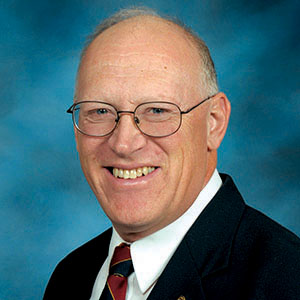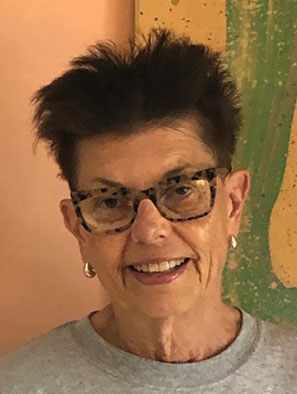Kansas Profile – Now That’s Rural: Susan Sutton, orphan trains
At a glance: A lecture at Cloud Community College on the history of orphan trains spurred interest in Concordia about the trainloads of homeless children who were transported by railroad from big cities in the east to new homes in the west. It led to the creation of the National Orphan Train Complex in Concordia.
More information: Ron Wilson, rwilson@ksu.edu, 785-532-7690
Photos: Ron Wilson | Susan Sutton
Website: Huck Boyd National Institute for Rural Development | National Orphan Train Complex
April 30, 2025

By Ron Wilson, director of the Huck Boyd National Institute for Rural Development at Kansas State University
What is more heart wrenching than the story of a child who suddenly becomes an orphan due to abandonment or the loss of a parent’s life? How does our society care for such children?
In the late 1800s, before the existence of the modern social service support system as we know it today, there was a movement of orphaned children from the big cities in the east to rural communities in the west.
Using the transportation available at the time, these children were put together in groups and traveled by railroad to be placed with families. These expeditions were called orphan trains.
One Kansas community is preserving and sharing the remarkable and touching stories of these orphans and the trains that brought them to new families and new homes in the west.
 Susan Sutton is board chair of the National Orphan Train Complex in Concordia. She is the retired dean of the humanities division at Cloud County Community College in Concordia. The college hosted a series of lecturers on various topics. One was on the topic of orphan trains.
Susan Sutton is board chair of the National Orphan Train Complex in Concordia. She is the retired dean of the humanities division at Cloud County Community College in Concordia. The college hosted a series of lecturers on various topics. One was on the topic of orphan trains.
At right: Susan Sutton | Download this photo
Orphan trains were a response to the overwhelming number of abandoned children in the big cities in the 1800s. Organizations such as the Children’s Aid Society (founded by a minister) and New York Foundling Hospital (founded by the Sisters of Charity) sought to find new homes for these children.
These agencies would screen interested families in the west and then send children by train to be placed with those families. Between 1854 and 1929, an estimated 250,000 homeless or orphaned children were transported in this way.
The practice of screening families and placing children in new homes was the precursor to the modern foster care system, now operated by state government agencies.
Concordia citizens became very interested in the orphan train history. It turned out that there were descendants of orphan train riders in the region. A committee was formed to explore creating a local museum on the topic.
“A colleague of mine in the humanities department had inherited the train depot in downtown Concordia,” Sutton said. “Her family had owned a furniture store and used the depot for mattress storage.”
The depot was built in 1917 but abandoned in the 1960s.
After a lot of research, the depot was placed on the National Register of Historic Places. It was renovated and became the first part of the complex. Donors helped support construction of a visitors center and the placement of seven nearby children’s statues, the first of many. An actual train car would be added later.
Sutton was also the college drama coach. “I told the students we should do a play,” Sutton said. Each student researched the life of a different orphan train rider and they scripted these into a theatrical production.
Meanwhile, a lady in Arkansas had been collecting memorabilia and artifacts about the orphan trains and their riders. She founded the Orphan Train Heritage Society of America.
Sutton contacted her and told her that Concordia was working on a museum on the topic. “Would you want any of my stuff?” the woman asked.
Ultimately, the Orphan Train Heritage Society of America chose Concordia as the repository for its artifacts. They are part of what is now the National Orphan Train Complex. It is the only museum in the country dedicated to preserving the orphan train story.
This is an impressive accomplishment for a rural community such as Concordia, population 5,111 people. Now, that’s rural.
Approximately 8,000 rider records are held in the museum. Artifacts and exhibits are placed throughout. They share the touching stories of so many individuals who came from terrible circumstances and were sent west to find new homes and new families.
“It all came together,” Sutton said. “We didn’t want this history to be lost.”
For more information, go to www.orphantraindepot.org.
What is more heart wrenching than an orphan losing his or her family? In
Concordia, these heart-wrenching stories become heart-warming.
And there’s more. Remember the train car and the growing number of statues? We’ll learn about those next week.
Audio and text files of Kansas Profiles are available at www.huckboydinstitute.org/kansas-profiles. For more information about the Huck Boyd Institute, interested persons can visit www.huckboydinstitute.org.
***

K‑State Research and Extension is a short name for the Kansas State University Agricultural Experiment Station and Cooperative Extension Service, a program designed to generate and distribute useful knowledge for the well‑being of Kansans. Supported by county, state, federal and private funds, the program has county extension offices, experiment fields, area extension offices and regional research centers statewide. Its headquarters is on the K‑State campus in Manhattan. For more information, visit www.ksre.ksu.edu. K-State Research and Extension is an equal opportunity provider and employer.